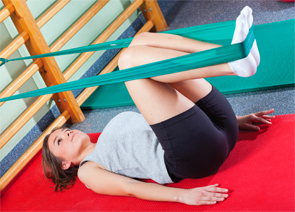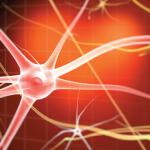
Physioyoga combines
physical therapy and yoga to help patients
restore and maintain optimal movement and function.
Photographee.eu/shutterstock.com
When rheumatoid arthritis (RA) left Stefanie Gluckman fighting chronic pain and relegated to a wheelchair, she turned to Lori Rubenstein Fazzio, DPT, PT, MAppSc, YTRX, of Mosaic Physical Therapy in Los Angeles, for relief.
Dr. Rubenstein Fazzio knows what it’s like to suffer from excruciating pain. After sustaining career-threatening injuries in a horseback accident in 2007, Dr. Rubenstein Fazzio was determined to return to her physical therapy (PT) practice. She credits physioyoga with helping her return to work, and she decided to integrate the practice—a mixture of physical therapy and yoga—into her clinic to help patients reclaim their lives.
By combining traditional physical therapy and yoga with evidence-based physiotherapy, physioyoga helps patients restore and maintain optimal movement and function. The practice is used by physical therapists who are also certified yoga instructors. As movement experts, Dr. Rubenstein Fazzio says physical therapists are uniquely qualified to integrate yoga into their practice.
“Physioyoga complements a patient’s traditional medical treatment by offering a more holistic approach to their rehabilitation experience,” Dr. Rubenstein Fazzio says. “When working with a client, I look beyond their illness or injury at factors, such as posture, breathing patterns, sleep issues, stress management, psycho-social issues and nutrition.”
After conducting a pre-assessment on each new patient, Dr. Rubenstein Fazzio designs an individual treatment plan that incorporates yoga poses, breathing methods and meditation. She notes that physioyoga relieves a patient’s stress, helps relax their nervous system and empowers patients to take part in their healing process.
“I work in collaboration with rheumatologists to incorporate physioyoga into individualized treatment plans and ensure positive outcomes for patients,” says Dr. Rubenstein Fazzio.
A Former Ballerina Gets Back on Her Feet
After undergoing five surgeries on multiple joints, Ms. Gluckman, a former ballet dancer in her mid-40s, was anxious to feel better, ditch the wheelchair and return to her job. Her rheumatologist recommended physical therapy as part of her rehabilitation plan and Ms. Gluckman started working with Dr. Rubenstein Fazzio.
“I’m a cynical East Coast Jewish woman, and at first, I was skeptical whether physioyoga would help,” Ms. Gluckman admits. “But with my RA flare-ups and unrelenting pain, I was willing to try just about anything that might help.”
Dr. Rubenstein Fazzio designed a physioyoga routine that Ms. Gluckman could do at home. The two met every other day for an hour at Dr. Rubenstein Fazzio’s clinic, and it didn’t take long for Ms. Gluckman to begin seeing results.
“Once Lori taught me how to meditate, I was able to achieve a pain-free state for 10–15 minutes at a time,” Ms. Gluckman says. “After four months, I saw a definite improvement in how I felt and the number of things I was able to accomplish.”
Recent research confirms that people who practice meditation can access different brain regions to reduce pain. A November 2015 study, conducted at Wake Forest Baptist Medical Center, found that mindfulness meditation reduced emotional pain by 47% and pain intensity by 27%.
After a year, Ms. Gluckman was able to return to work full time and no longer needs a wheelchair. In fact, she has even taken up hiking.
Physioyoga: Going Beyond Traditional Physical Therapy
Yoga and PT have many common goals, including flexibility, strength, motor control, balance, posture and alignment, but Dr. Rubenstein Fazzio says one of the main differences is how breathing and visualization techniques are employed.
“Stress exacerbates many health problems, and yoga can balance stress and empower patients through visualization, meditation and asana [yoga postures],” explains Dr. Rubenstein Fazzio.
Pam Douglas, a writer based in Los Angeles, found this to be the case when she was referred to Dr. Rubenstein Fazzio’s clinic after tearing her meniscus.
“I initially saw Lori for my knee, but I also had back and shoulder problems, and in 2005, I underwent scoliosis surgery and had steel rods implanted in my spine,” Ms. Douglas says. “Lori explained that unless we corrected my posture and the way I walked, I would probably continue to experience pain.”
Over the course of three months, Dr. Rubenstein Fazzio worked with Ms. Douglas on stretches and yoga movements that would strengthen the back of her legs to better support her back.
“It was as much about learning how to care for my body as it was fixing it,” Ms. Douglas says. “In the beginning, Lori had to modify some of the exercises to avoid unnecessary stress on my joints and ligaments, but the end result was tremendous pain relief, more strength and increased range of motion.”
Ms. Douglas says physioyoga helped her visualize her healing process and how to work with her body to achieve the best possible outcomes.
“While a traditional physical therapist would have focused on my injury, Lori went beyond that and looked at how my injured knee impacted my entire body,” Ms. Douglas says. “She’s truly a gifted practitioner.”
Dr. Rubenstein Fazzio, who is on faculty at Loyola Marymount University and is certified as a yoga teacher by Samata International Yoga and Health Institute, says the practice of physioyoga has received increased media attention over the past two years since actress Kim Cattrall of Sex and the City fame credited the practice—which she nicknamed fizzy yoga—with helping her get through a grueling performance schedule for a London play.
“Physioyoga helps patients recover both mentally and physically,” says Dr. Rubenstein Fazzio, who notes the practice can help patients with a variety of health conditions, including back and neck pain, musculoskeletal injuries, osteoarthritis, rheumatoid arthritis, neurological conditions, migraines, fibromyalgia, incontinence and irritable bowel syndrome.
“When people think of yoga, they think of poses, but physioyoga is so much more than that,” Dr. Rubenstein Fazzio says. “For example, if a patient is suffering from neck pain, we also look at how changing their breathing patterns affects their neck pain and how they can manage stress better.”
Research has shown that yoga can help reduce pain, while also offering physical and psychological benefits for arthritis patients. A 2013 study conducted at the University of Cincinnati, Ohio, showed that arthritis patients who practiced yoga regularly reduced their pain levels, improved movement, had less morning stiffness and experienced reduced levels of depression.
Yet, Dr. Rubenstein Fazzio cautions that it’s also important for patients and rheumatologists to work with a physical therapist who has been trained in yoga techniques, rather than having a patient take a yoga class or attempt yoga on their own.
“A physical therapist who has undergone yoga training can develop a treatment plan that a patient can practice in a safe and effective manner without risking further injury,” Dr. Rubenstein Fazzio says. “Physical therapists are trained to incorporate a patient’s medical history and current physical functioning to ensure proper modifications to yoga as necessary.”
Linda Childers is a health writer located in the San Francisco Bay Area.

